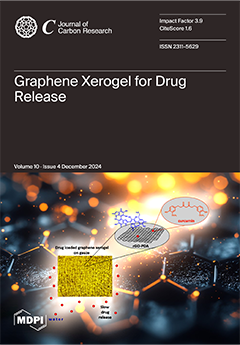Graphitic carbon nitride (g-C
3N
4) has gained significant attention due to its unique physicochemical properties as a metal-free, two-dimensional, carbon-based polymeric fluorescent substance composed of tris-triazine-based patterns with a slight hydrogen content and a carbon-to-nitrogen ratio of 3:4. It forms
[...] Read more.
Graphitic carbon nitride (g-C
3N
4) has gained significant attention due to its unique physicochemical properties as a metal-free, two-dimensional, carbon-based polymeric fluorescent substance composed of tris-triazine-based patterns with a slight hydrogen content and a carbon-to-nitrogen ratio of 3:4. It forms layered structures like graphite and demonstrates exciting and unusual physicochemical properties, making g-C
3N
4 widely used in nanoelectronic devices, spin electronics, energy storage, thermal conductivity materials, and many others. The biomedical industry has greatly benefited from its excellent optical, electrical, and physicochemical characteristics, such as abundance on Earth, affordability, vast surface area, and fast synthesis. Notably, the heptazine phase of g-C
3N
4 displays stable electronic bands. Another significant quality of this semiconductor material is its excellent fluorescence property, which is also helpful in preparing biosensors. Based on g-C
3N
4, electrochemical biosensors have provided better biocompatibility, higher sensitivity, low detection limits, nontoxicity, excellent selectivity, and surface versatility of functionalization for the delicate identification of target analytes. This review covers the latest studies on using efflorescent graphitic carbon nitride to fabricate electrochemical biosensors for various biomarkers. Carbon nitrides have been reported to possess excellent electroactivity properties, a massive surface-to-volume ratio, and hydrogen-bonding functionality, thus allowing electrochemical-based, highly sensitive, and selective detection platforms for an entire array of analytes. Considering the preceding information, this review addresses the fundamentals and background of g-C
3N
4 and its numerous synthesis pathways. Furthermore, the importance of electrochemical sensing of diverse biomarkers is emphasized in this review article. It also discusses the current status of the challenges and future perspectives of graphitic carbon nitride-based electrochemical sensors, which open paths toward their practical application in aspects of clinical diagnostics.
Full article





